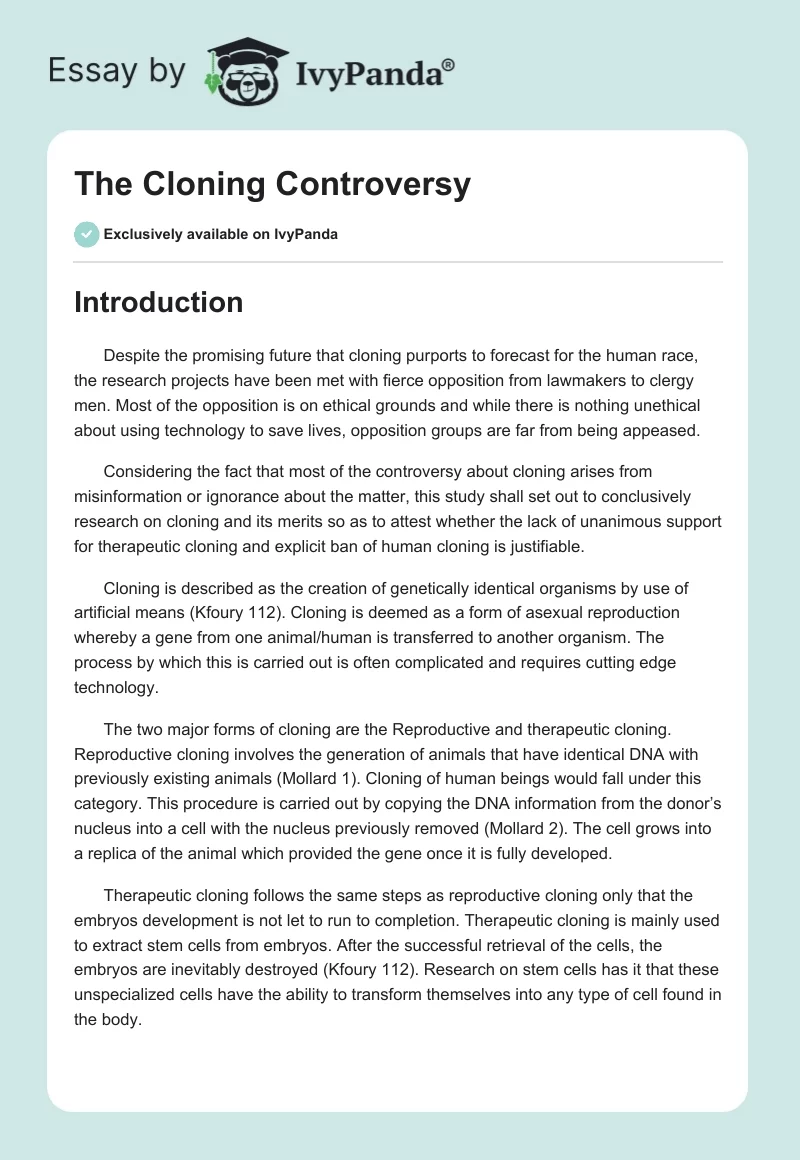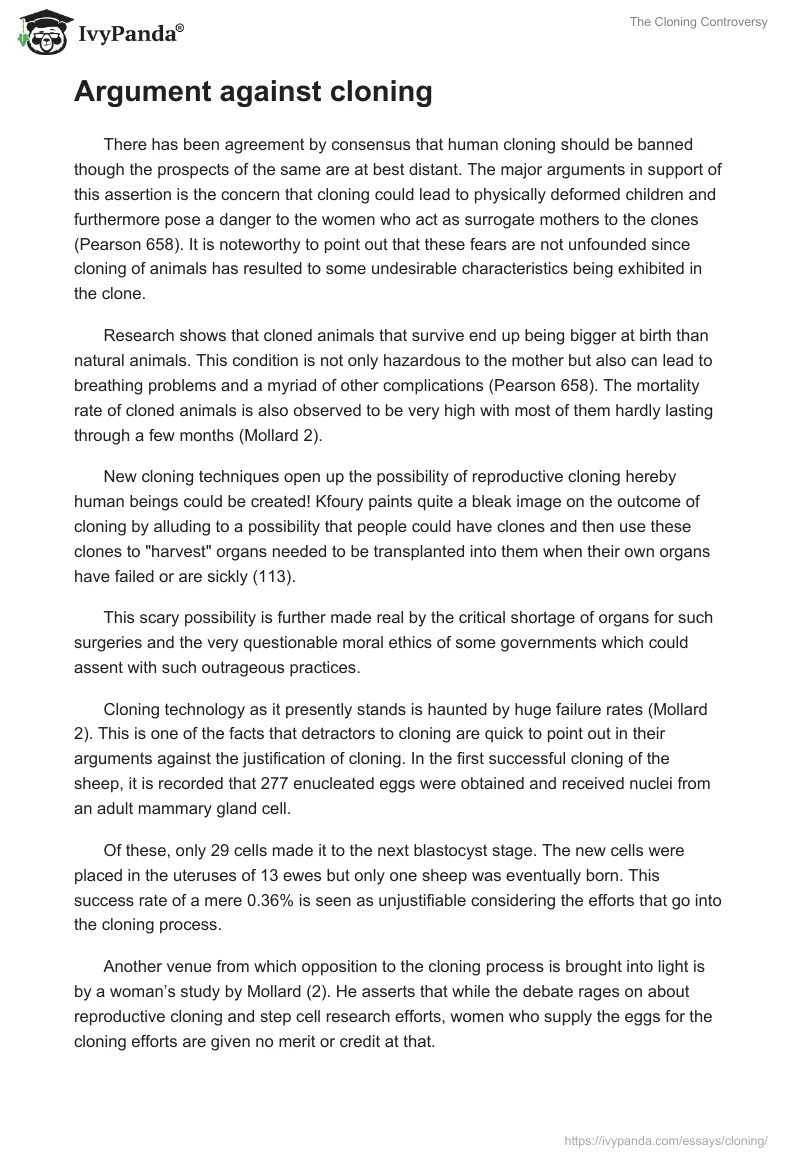Introduction
Despite the promising future that cloning purports to forecast for the human race, the research projects have been met with fierce opposition from lawmakers to clergy men. Most of the opposition is on ethical grounds and while there is nothing unethical about using technology to save lives, opposition groups are far from being appeased.
Considering the fact that most of the controversy about cloning arises from misinformation or ignorance about the matter, this study shall set out to conclusively research on cloning and its merits so as to attest whether the lack of unanimous support for therapeutic cloning and explicit ban of human cloning is justifiable.
Cloning is described as the creation of genetically identical organisms by use of artificial means (Kfoury 112). Cloning is deemed as a form of asexual reproduction whereby a gene from one animal/human is transferred to another organism. The process by which this is carried out is often complicated and requires cutting edge technology.
The two major forms of cloning are the Reproductive and therapeutic cloning. Reproductive cloning involves the generation of animals that have identical DNA with previously existing animals (Mollard 1). Cloning of human beings would fall under this category. This procedure is carried out by copying the DNA information from the donor’s nucleus into a cell with the nucleus previously removed (Mollard 2). The cell grows into a replica of the animal which provided the gene once it is fully developed.
Therapeutic cloning follows the same steps as reproductive cloning only that the embryos development is not let to run to completion. Therapeutic cloning is mainly used to extract stem cells from embryos. After the successful retrieval of the cells, the embryos are inevitably destroyed (Kfoury 112). Research on stem cells has it that these unspecialized cells have the ability to transform themselves into any type of cell found in the body.
Argument against cloning
There has been agreement by consensus that human cloning should be banned though the prospects of the same are at best distant. The major arguments in support of this assertion is the concern that cloning could lead to physically deformed children and furthermore pose a danger to the women who act as surrogate mothers to the clones (Pearson 658). It is noteworthy to point out that these fears are not unfounded since cloning of animals has resulted to some undesirable characteristics being exhibited in the clone.
Research shows that cloned animals that survive end up being bigger at birth than natural animals. This condition is not only hazardous to the mother but also can lead to breathing problems and a myriad of other complications (Pearson 658). The mortality rate of cloned animals is also observed to be very high with most of them hardly lasting through a few months (Mollard 2).
New cloning techniques open up the possibility of reproductive cloning hereby human beings could be created! Kfoury paints quite a bleak image on the outcome of cloning by alluding to a possibility that people could have clones and then use these clones to “harvest” organs needed to be transplanted into them when their own organs have failed or are sickly (113).
This scary possibility is further made real by the critical shortage of organs for such surgeries and the very questionable moral ethics of some governments which could assent with such outrageous practices.
Cloning technology as it presently stands is haunted by huge failure rates (Mollard 2). This is one of the facts that detractors to cloning are quick to point out in their arguments against the justification of cloning. In the first successful cloning of the sheep, it is recorded that 277 enucleated eggs were obtained and received nuclei from an adult mammary gland cell.
Of these, only 29 cells made it to the next blastocyst stage. The new cells were placed in the uteruses of 13 ewes but only one sheep was eventually born. This success rate of a mere 0.36% is seen as unjustifiable considering the efforts that go into the cloning process.
Another venue from which opposition to the cloning process is brought into light is by a woman’s study by Mollard (2). He asserts that while the debate rages on about reproductive cloning and step cell research efforts, women who supply the eggs for the cloning efforts are given no merit or credit at that.
The health risks associated with the egg extraction process are seen to be great and in light of the high rate of failure currently associated with the cloning process, Mollard contests that serious ethical implications are raised regarding the process (2).
Argument for cloning
From a medical point of view, cloning also presents a new way in which research into diseases can be undertaken. It is articulated that animals that carry genetic defect that mimic human diseases can be generated through cloning (North Carolina Association for Biomedical Research 2). These “sickly” animals could then be used for the study of the diseases and the findings obtained from this would be of immense value in finding of effective therapies for treating the disease in humans (Wolfe 3).
Sadly, majority of the people awaiting organs for transplant will end up not receiving the much needed organs. Therapeutic cloning presents a long term solution to this problem which is only set to escalate.
Cloning of individual human organs e.g. the kidney, heart, etc. presents a novel way of coming up with organs for transplant as patients will no longer have to rely on the altruist tendencies of fellow men, which cannot always be guaranteed (Lanza 283). In addition, this cloning will ensure that organ rejection is a thing of the past (Kfoury 113).
In addition to these prospects of creating high quality breeds in industrial scale numbers, there is also the possibility of modifying the DNA of the clones such that they posses some key proteins that are not normally present in the animal but are of huge benefit to human beings (Lanza 283). This can lead to the increasing in the nutritional worth of the animals and the presentation of healthier food products for people since the nutritional composition of the product can be “tweaked” to best suit the consumer. This will lead to a healthier nation.
While antagonism over the safety of cloned animal products has incessantly been questioned, majority of the people have began viewing cloning as one of the feasible ways of creating means of feeding a world whose population is constantly on the rise (North Carolina Association for Biomedical Research 2).
Cloning presents a way of ensuring that the precise quality of food can be harvested over and over. In light of the recent financial crises and the increased food insecurity issues especially in developing counties, such moves that promise adequate food supplies are welcome.
Conclusion
This study set out on a quest to state if the banning of cloning research efforts was justifiable. Considering the numerous benefits that further research would have presented, I would view this ban as grossly unjustifiable. Should the ban on funding of cloning projects not have been made, one can only guess at the numerous groundbreaking achievements that could have been made by now.
The novel ideal of individual organ cloning would have alleviated the present problem that is so prevalent in the health care system. In addition, the global food crisis would be significantly averted among other benefits.
Works Cited
Kfoury, Charlotte. “Therapeutic cloning: promises and issues.” MJM, 10.2 2007:112-120. Print.
Lanza, Robert. “After Dolly: the use and misuse of human cloning (BOOK REVIEW).” The journal of clinical investigation, 117.2 2007: 283. Print.
Mollard, Richard. Reproductive cloning. 2005. Web.
North Carolina Association for Biomedical Research. Cloning. 2006. Web.
Pearson, Yvette. “Never Let Me Clone? Countering an Ethical Argument against the Reproductive Cloning of Humans.” European Molecular Biology Organization, 7.7 2006: 657-59. Print.
Wolfe, John. “Gene Therapy in Large Animal Models of Human Genetic Diseases.” ILAR J, 50.2 2009: 107-111. Print.


